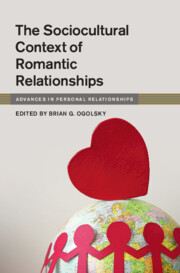Book contents
- The Sociocultural Context of Romantic Relationships
- Advances in Personal Relationships
- The Sociocultural Context of Romantic Relationships
- Copyright page
- Contents
- Contributors
- 1 The Sociocultural Context of Romantic Relationships
- 2 Systemic Racism and Romantic Relationships
- 3 Sociocultural Perspectives on Romantic Relationships
- 4 Gender and Heteronormativity in Romantic Relationships
- 5 Social Class, Neighborhoods, and Romantic Relationships
- 6 Religion and Spirituality in Romantic Relationships
- 7 The Importance of Work in Romantic Relationships
- 8 History and Cohort Effects in Romantic Relationships
- 9 The Legal Meaning of Sex (and Romantic Relationships)
- 10 Romantic Relationships and Traditional Media
- 11 Romantic Relationships and Social Media
- 12 Situating Latinx Immigrant Romantic Relationships in the Context of Illegality
- 13 Romantic Relationships during a Global Pandemic
- Index
- References
6 - Religion and Spirituality in Romantic Relationships
Published online by Cambridge University Press: 19 October 2023
- The Sociocultural Context of Romantic Relationships
- Advances in Personal Relationships
- The Sociocultural Context of Romantic Relationships
- Copyright page
- Contents
- Contributors
- 1 The Sociocultural Context of Romantic Relationships
- 2 Systemic Racism and Romantic Relationships
- 3 Sociocultural Perspectives on Romantic Relationships
- 4 Gender and Heteronormativity in Romantic Relationships
- 5 Social Class, Neighborhoods, and Romantic Relationships
- 6 Religion and Spirituality in Romantic Relationships
- 7 The Importance of Work in Romantic Relationships
- 8 History and Cohort Effects in Romantic Relationships
- 9 The Legal Meaning of Sex (and Romantic Relationships)
- 10 Romantic Relationships and Traditional Media
- 11 Romantic Relationships and Social Media
- 12 Situating Latinx Immigrant Romantic Relationships in the Context of Illegality
- 13 Romantic Relationships during a Global Pandemic
- Index
- References
Summary
Using Mahoney’s Relational Spirituality Framework, we summarize mixed evidence that has linked global markers of general involvement in religion to the formation (partner selection, decisions to cohabit, date or marry), maintenance (union satisfaction, infidelity, domestic violence), and dissolution (divorce) of romantic relationships. We then examine four specific religious/spiritual (RS) factors that have been robustly tied to better relationship functioning: sanctification, spiritual intimacy, prayer for partner, and positive RS coping. Next, we discuss more rare but toxic RS factors that can undermine the quality of romantic unions and the well-being of the partners, particularly after romantic dissolution or divorce. We hope this chapter helps readers appreciate the roles of religion and spirituality, for better and worse, for romantic relationships.
Keywords
- Type
- Chapter
- Information
- The Sociocultural Context of Romantic Relationships , pp. 90 - 114Publisher: Cambridge University PressPrint publication year: 2023
References
- 1
- Cited by



